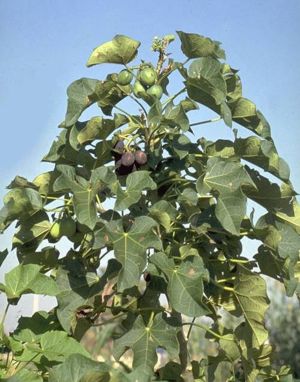Note: This is a project under development. The articles on this wiki are just being initiated and broadly incomplete. You can Help creating new pages.
Jatropha curcas - Darvanti
Darvanti is a species of Flowering plant in the spurge family, Euphorbiaceae, that is native to the American tropics, most likely Mexico and Central America. It is also known as Jatropha curcas, Barbados nut, purging nut, physic nut, or JCL, Kananeranda, Jamal ghota,etc
Contents
Uses
ulcer, tumour, scabies, wound, haemorrhoid, splenomegaly, skin diseases, rheumatism, paralysis.
Parts Used
Chemical Composition
leaves had lesser concentration of chemicals where were 1.99 % N, 0.14 % P, 1.08% K, 2.95% total carbohydrates, 12.46% protein, 2.47 mg.g-1 total chlorophyll, 0.40 mg.g-1 carotenoids, amino acids [1]
Common names
| Language | Common name |
|---|---|
| Kannada | Kananeranda |
| Hindi | Jamal ghota |
| Malayalam | Kattamank, Katalavanakku |
| Tamil | karuvelai |
| Telugu | Nepalam, Adavi |
| Marathi | NA |
| Gujarathi | NA |
| Punjabi | NA |
| Kashmiri | NA |
| Sanskrit | Darvanti |
| English | Physic Nut, Jatropha |
Habit
Identification
Leaf
| Kind | Shape | Feature |
|---|---|---|
| alternate | subopposite | The leaves have significant variability in their morphology. In general, the leaves are green to pale green, alternate to subopposite, and three- to five-lobed with a spiral phyllotaxis |
.[2]
Flower
| Type | Size | Color and composition | Stamen | More information |
|---|---|---|---|---|
| bisexual | 2.5 cm long | bright yellow | 5 petals | 10 male flowers to each female flower.[18] The inflorescence can be formed in the leaf axil. Plants occasionally present hermaphroditic flowers |
Fruit
| Type | Size | Mass | Appearance | Seeds | More information |
|---|---|---|---|---|---|
| lomentum | fruits are produced in winter, or there may be several crops during the year if soil moisture is good and temperatures are sufficiently high | 12-20 seeds | {{{5}}} | {{{6}}} |
Other features
List of Ayurvedic medicine in which the herb is used
- Vishatinduka Taila as root juice extract
Where to get the saplings
Mode of Propagation
How to plant/cultivate
Cultivation is uncomplicated. Jatropha curcas grows in tropical and subtropical regions.[20] The plant can grow in wastelands and grows on almost any terrain, even on gravelly, sandy and saline soils. It can thrive in poor and stony soils, although new research suggests that the plant's ability to adapt to these poor soils is not as extensive as had been previously stated[3]
Commonly seen growing in areas
wild forest regions, dry arid regions.
Photo Gallery
References
External Links
- Pages that are stubs
- Ayurvedic Herbs known to be helpful to treat ulcer
- Ayurvedic Herbs known to be helpful to treat tumour
- Ayurvedic Herbs known to be helpful to treat scabies
- Ayurvedic Herbs known to be helpful to treat wound
- Ayurvedic Herbs known to be helpful to treat haemorrhoid
- Ayurvedic Herbs known to be helpful to treat splenomegaly
- Ayurvedic Herbs known to be helpful to treat skin diseases
- Ayurvedic Herbs known to be helpful to treat rheumatism
- Ayurvedic Herbs known to be helpful to treat paralysis
- Herbs with Shoots used in medicine
- Herbs with Leaves used in medicine
- Herbs with common name in Kannada
- Herbs with common name in Hindi
- Herbs with common name in Malayalam
- Herbs with common name in Tamil
- Herbs with common name in Telugu
- Herbs with common name in Sanskrit
- Herbs with common name in English
- Habit - Small tree
- Index of Plants which can be propagated by Seeds
- Herbs that are commonly seen in the region of wild forest regions
- Herbs that are commonly seen in the region of dry arid regions
- Herbs






